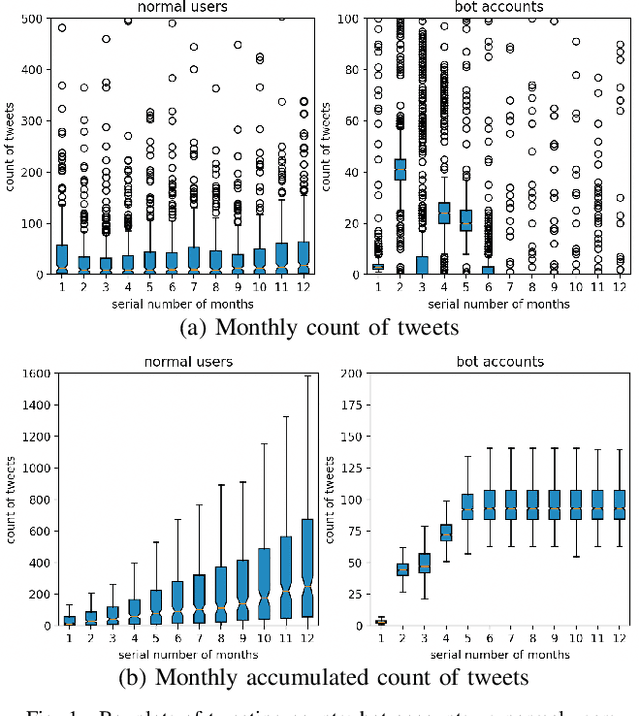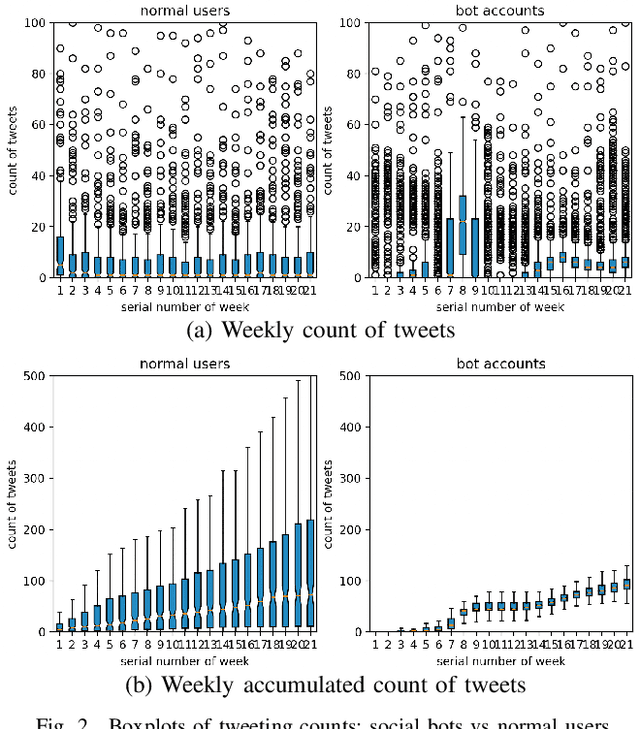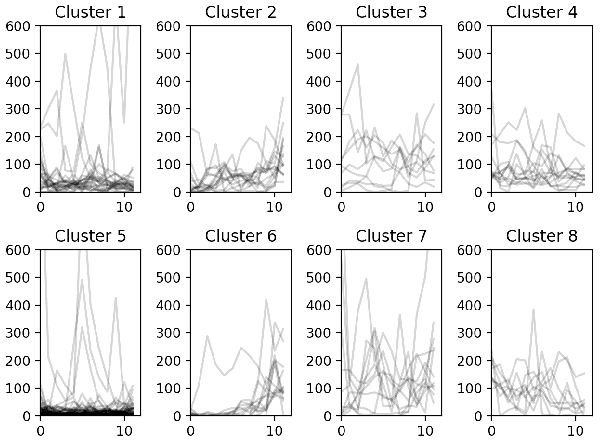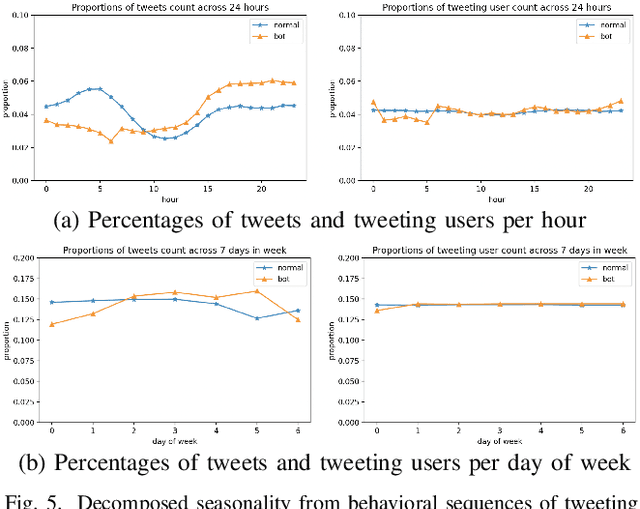Xuesong Ye
FakeSwarm: Improving Fake News Detection with Swarming Characteristics
May 30, 2023Abstract:The proliferation of fake news poses a serious threat to society, as it can misinform and manipulate the public, erode trust in institutions, and undermine democratic processes. To address this issue, we present FakeSwarm, a fake news identification system that leverages the swarming characteristics of fake news. To extract the swarm behavior, we propose a novel concept of fake news swarming characteristics and design three types of swarm features, including principal component analysis, metric representation, and position encoding. We evaluate our system on a public dataset and demonstrate the effectiveness of incorporating swarm features in fake news identification, achieving an f1-score and accuracy of over 97% by combining all three types of swarm features. Furthermore, we design an online learning pipeline based on the hypothesis of the temporal distribution pattern of fake news emergence, validated on a topic with early emerging fake news and a shortage of text samples, showing that swarm features can significantly improve recall rates in such cases. Our work provides a new perspective and approach to fake news detection and highlights the importance of considering swarming characteristics in detecting fake news.
MedLens: Improve mortality prediction via medical signs selecting and regression interpolation
May 19, 2023Abstract:Monitoring the health status of patients and predicting mortality in advance is vital for providing patients with timely care and treatment. Massive medical signs in electronic health records (EHR) are fitted into advanced machine learning models to make predictions. However, the data-quality problem of original clinical signs is less discussed in the literature. Based on an in-depth measurement of the missing rate and correlation score across various medical signs and a large amount of patient hospital admission records, we discovered the comprehensive missing rate is extremely high, and a large number of useless signs could hurt the performance of prediction models. Then we concluded that only improving data-quality could improve the baseline accuracy of different prediction algorithms. We designed MEDLENS, with an automatic vital medical signs selection approach via statistics and a flexible interpolation approach for high missing rate time series. After augmenting the data-quality of original medical signs, MEDLENS applies ensemble classifiers to boost the accuracy and reduce the computation overhead at the same time. It achieves a very high accuracy performance of 0.96% AUC-ROC and 0.81% AUC-PR, which exceeds the previous benchmark.
FineEHR: Refine Clinical Note Representations to Improve Mortality Prediction
May 04, 2023Abstract:Monitoring the health status of patients in the Intensive Care Unit (ICU) is a critical aspect of providing superior care and treatment. The availability of large-scale electronic health records (EHR) provides machine learning models with an abundance of clinical text and vital sign data, enabling them to make highly accurate predictions. Despite the emergence of advanced Natural Language Processing (NLP) algorithms for clinical note analysis, the complex textual structure and noise present in raw clinical data have posed significant challenges. Coarse embedding approaches without domain-specific refinement have limited the accuracy of these algorithms. To address this issue, we propose FINEEHR, a system that utilizes two representation learning techniques, namely metric learning and fine-tuning, to refine clinical note embeddings, while leveraging the intrinsic correlations among different health statuses and note categories. We evaluate the performance of FINEEHR using two metrics, namely Area Under the Curve (AUC) and AUC-PR, on a real-world MIMIC III dataset. Our experimental results demonstrate that both refinement approaches improve prediction accuracy, and their combination yields the best results. Moreover, our proposed method outperforms prior works, with an AUC improvement of over 10%, achieving an average AUC of 96.04% and an average AUC-PR of 96.48% across various classifiers.
BotTriNet: A Unified and Efficient Embedding for Social Bots Detection via Metric Learning
Apr 18, 2023



Abstract:A persistently popular topic in online social networks is the rapid and accurate discovery of bot accounts to prevent their invasion and harassment of genuine users. We propose a unified embedding framework called BotTriNet, which utilizes textual content posted by accounts for bot detection based on the assumption that contexts naturally reveal account personalities and habits. Content is abundant and valuable if the system efficiently extracts bot-related information using embedding techniques. Beyond the general embedding framework that generates word, sentence, and account embeddings, we design a triplet network to tune the raw embeddings (produced by traditional natural language processing techniques) for better classification performance. We evaluate detection accuracy and f1score on a real-world dataset CRESCI2017, comprising three bot account categories and five bot sample sets. Our system achieves the highest average accuracy of 98.34% and f1score of 97.99% on two content-intensive bot sets, outperforming previous work and becoming state-of-the-art. It also makes a breakthrough on four content-less bot sets, with an average accuracy improvement of 11.52% and an average f1score increase of 16.70%.
BotShape: A Novel Social Bots Detection Approach via Behavioral Patterns
Mar 17, 2023



Abstract:An essential topic in online social network security is how to accurately detect bot accounts and relieve their harmful impacts (e.g., misinformation, rumor, and spam) on genuine users. Based on a real-world data set, we construct behavioral sequences from raw event logs. After extracting critical characteristics from behavioral time series, we observe differences between bots and genuine users and similar patterns among bot accounts. We present a novel social bot detection system BotShape, to automatically catch behavioral sequences and characteristics as features for classifiers to detect bots. We evaluate the detection performance of our system in ground-truth instances, showing an average accuracy of 98.52% and an average f1-score of 96.65% on various types of classifiers. After comparing it with other research, we conclude that BotShape is a novel approach to profiling an account, which could improve performance for most methods by providing significant behavioral features.
 Add to Chrome
Add to Chrome Add to Firefox
Add to Firefox Add to Edge
Add to Edge